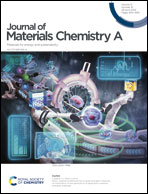Red blood cell (RBC)-like Ni@N–C composites for efficient electrochemical CO2 reduction and Zn–CO2 batteries†
Abstract
The development of highly active and selective electrocatalysts for the reduction of CO2 into valuable products presents a promising avenue for addressing the energy crisis and mitigating the greenhouse effect. In this study, we introduce a ligand-assisted supermolecule-derived red blood cell (RBC)-like catalyst composed of nickel and nitrogen-doped carbon (Ni@NC) for electrocatalytic carbon dioxide reduction reaction (eCO2RR) and Zn–CO2 battery applications. Among the various samples prepared, Ni@NC-950 exhibited the highest activity and demonstrated a faradaic efficiency of CO (FECO) greater than 90% across a wide potential range from −0.6 to −1.0 V [vs. reversible hydrogen electrode (RHE)], with a peak FECO of 97.8% achieved at −0.8 V. This translated to a remarkable partial current density (jCO) of 22.5 mA cm−2. When employed as the cathode catalyst in a Zn–CO2 battery, the Ni@NC-950 catalyst delivered a peak power density of 2.36 mW cm−2 at a current density of 10.97 mA cm−2. Importantly, the battery exhibited robust long-term discharge capability, operating continuously and steadily at 5 mA cm−2 for 20 hours.

- This article is part of the themed collection: Journal of Materials Chemistry A HOT Papers


 Please wait while we load your content...
Please wait while we load your content...